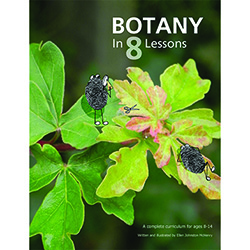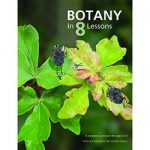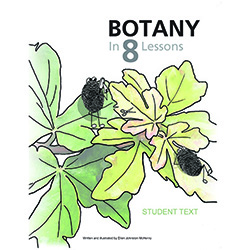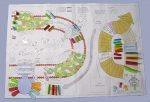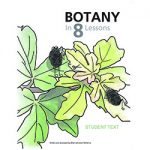Botany in 8 Lessons (Digital Download)
$18.95
A complete curriculum designed for ages 8-14. Includes both student text and teacher’s activity guide. Over 200 pages, color illustrations included.
- Description
Description
This download gives you the exact same content as the paperback. The only difference is that with the digital download you get it cheaper and faster. (This digital download comes with the audio files, too, so you don’t need to use the separate audio download.) You can make a printed copy of the text, or you can “go green” and read the text on the screen, printing out only the pages necessary for the games.
VIDEO REVIEW of the curriculum: https://youtu.be/tdlELmivoBs
CLICK HERE TO DOWNLOAD FREE SAMPLE CHAPTERS
CLICK HERE TO DOWNLOAD SAMPLE OF ACTIVITY SECTION
About the student text: The 100-page student text has 8 chapters, and each chapter is divided into two levels. All students complete level 1. Students who are younger or who have limited interest may want to stop after level 1. Level 2 provides additional information on the same topic for students who want to read more. You can choose to do some level 2s and skip others. At the end of each level there are review activities such as quiz questions, crossword puzzles, letter puzzles and Internet links that provide videos or online activities. The table of contents is included with the free download of the first two chapters.
Summary of contents: Chapter 1: Plant cell anatomy and photosynthesis, Chapter 2: Plant classification (vascular, non-vascular, seeds, seedless, angiosperms, gymnosperms, monocots, dicots), Kingdom/phylum/class/order/family/genus/species, where some plant names came from, Chapter 3: Non-vascular plants (mosses, liverworts, osmosis, alternation of generations), Chapter 4: Vascular structures (xylem, phloem), transpiration, monocots, dicots, plant hormones, tropisms), Chapter 5: Leaf anatomy, classification of leaf arrangements (pinnate, palmate, etc.), stomata, pigments, herbaceous and woody stems, leaf shapes, Chapter 6: Reproduction in ferns, reproduction in gymnosperms and angiosperms, pollination, germination, classification of fruits (dry fruits, succulents, etc.), legumes, types of seeds, spores, Chapter 7: Adaptations (desert, carnivorous, under water), poisonous and parasitic plants, Chapter 8: Diseases, brief intro to fungi, viruses, bacteria, famous diseases (tobacco mosaic, etc.), galls, plant nutrition, plant pests
About the activity section: The activity section has over 100 pages of supplemental games, crafts, and experiments. Games provided include two games about photosynthesis, Tree Leaf Bingo, Plant Cell Penny Pitch, “Where Sheep May Safely Graze” (a game about poisonous plants), “Plant Pile Up” (a general review game), a scavenger hunt, and directions for downloading two games about flower identification. Labs include flower dissection, dissecting xylem tubes out of celery, experimenting with growing roots, testing soil pH, testing the strength of germinating seeds, testing percentage germination of seed packets, looking at pollen grains, experimenting with ethylene gas and ripening fruit, and watching osmosis. Art/craft activities include drawing the cross section of a leaf, a streaming chloroplasts flip book, an ATP pop gun, vascular cross section cookies, pressing leaves, and making a work of art from a microscopic cross section photo. A final review/test is also included. (Also, at the very back of the book are some “consumable” color pages that can be removed and used.)
Lapbook: Also included at the end of the activity section are patterns for over a dozen lapbook items. Many of these include gimmicks such as lifting flaps, pull tabs or pop-ups. (A visual overview of the lapbook is posted on YouTube.com/TheBasementWorkshop, on the Botany playlist.)
Supplemental videos: A special channel for this curriculum has been set up on YouTube.com/TheBasementWorkshop. It contains videos that correlate with each chapter. Most videos have been embedded from other sources, but a few were created specially for this curriculum. All videos have been thoroughly previewed.
Extra student texts: If you would like to have extra copies of the student text section of this booklet (for multiple students), these are available through Amazon.com. They are $11.95 and are printed in color. Go to Amazon and type in “Botany in 8 Lessons; Student Text.”
FAQs:
–How long would it take to complete this curriculum? Probably a minimum of 4 to 5 weeks if you really raced through it, and more like 6-8 weeks if you go at a relaxed pace. You could even stretch it to 9 or 10 weeks if you added in other activities (gardening, field trips, etc.) It really depends on how many hours per week you spend on science, and how long you spend on each activity (and whether you watch all the videos). Some students might want to play the games multiple times, or spend extra time on their art activities. You can make this curriculum fit your schedule.
–Can I just pull out what I need and not do the entire curriculum? Sure. You can combine parts of this curriculum with another curriculum, or a batch of library books, and create your own super-unit!
–Would it be possible to use this with kids older than 14? The content is basically “high school biology,” so yes, you can. If your high schooler still likes entertaining writing and lots of activities, you could use this for high school science credit.

